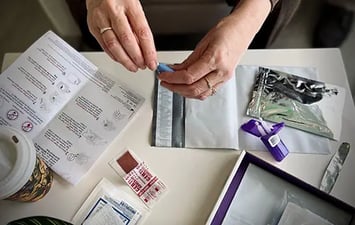Share this
overcoming clinical trial challenges in patient recruitment
by Neoteryx Microsampling on Jan 9, 2018 4:46:00 AM
Before a new drug or treatment is made available to the general public, a clinical trial helps pharmaceutical companies, and their partners gather important information about a drug's safety and efficacy.
That's why clinical trials are one of the essential stages of developing and testing new drugs and treatments before bringing them to market. However, recruiting and retaining trial participants is increasingly difficult. Patient recruitment for clinical trials can be challenging and draining.

Barriers to Recruitment in Clinical Trials
- Awareness: Physicians and other clinicians may simply not be aware that trials are available to their patients, or they may assume that their patients are not suitable or eligible for recruitment. This points to a clear need for better communication between pharmaceutical companies and medical practitioners.
- Poor Communication with Physicians: Clinical trials are often targeted to patients suffering from a specific condition or disease. Many physicians treating that specific patient population may not be willing to lose control over their care and their current treatment plan. Physicians who are better informed about the contexts of studies, including the benefits and potential issues of a drug or other treatment that is going to be trialed, can better recognize the potential benefits for their patients. It is important for clinical trial managers to communicate with healthcare providers to ensure they see the value in the potential treatment. The communications should also clarify if there is an additional administrative burden associated with the clinical trial.
- Trial Advertising and Volunteer Screening: Not all clinical trial volunteer referrals come from physicians. Trials rely heavily on direct recruitment through advertisements geared to people with certain conditions or in certain patient populations. One of the challenges this approach brings is the additional time and effort needed to screen the applicants who may not be suitable for the trial. The length of this recruiting and screening process can be off-putting for some patients being recruited.
Clinical Trial Barriers for Participants
A crucial element in any clinical trial is the participants. There are many reasons why participation in trials is low, and why retaining participants until the end of the trial is difficult.
Many potential participants aren't joining research studies or trials because of lack of awareness, either through poorly targeted advertising or lack of physician involvement. Lack of access to trials also causes problems. Where trials are not promoted and designed on a local level, participants in certain communities may be unable to travel great distances to reach a trial site. They are likely busy with work or family commitments, or they just cannot afford the travel costs and the time.
Additionally, people may fear that the drugs or other therapies being tested in a clinical trial may have negative side effects. What about the tests they must undergo as part of the trial? They may mistrust the true motivation or purpose for such tests. If they have a fear of needles, they may be reluctant to join a trial that requires routine venipuncture blood draws for lab testing.
Tackling Clinical Trial Challenges
If clinical trials are to be effective, useful, and cost-efficient, the above mentioned and other challenges need to be met and overcome, including the most difficult ones: fear and mistrust. While patients fear new drugs and treatments and see only the risks associated with trials, they are unlikely to volunteer to take part or spread the word to others.
To combat the challenges, Kadam and colleagues suggest the involvement of dedicated clinical research coordinators (CRCs) to help create positive awareness about research and clinical trials among different communities. These coordinators may also have solutions for better targeting of participants through predesigned recruitment strategies.
Offer Remote, Mail-in Participation Options
To increase their volunteer recruitment rates, many pharmaceutical companies and the contract research organizations (CROs) who partner with them are offering people the option to participate in clinical trials from home.
/Mitra_Media%20Library%20Images%20(March-April%202023)/Mitra%202-Sampler%20Cartridge%20and%20Collection%20Kit.jpg?width=348&height=232&name=Mitra%202-Sampler%20Cartridge%20and%20Collection%20Kit.jpg) Remote participation can be enabled by offering volunteers the option to collect their own specimen samples at home using Sample Collection Kits.
Remote participation can be enabled by offering volunteers the option to collect their own specimen samples at home using Sample Collection Kits.
These kits, which contain Mitra® microsampling devices and all the supplies needed for remote blood sample collection, can be mailed to their homes. No more time-consuming trips to the trial facility!
 Using a Mitra device and the illustrated instructions and supplies in the kit box, study participants can use a finger-stick method to self-collect a couple of blood samples from a fingertip. The Mitra device is based on volumetric absorptive microsampling, which enables anyone to collect a tiny but precise volume of blood for accurate lab analysis.
Using a Mitra device and the illustrated instructions and supplies in the kit box, study participants can use a finger-stick method to self-collect a couple of blood samples from a fingertip. The Mitra device is based on volumetric absorptive microsampling, which enables anyone to collect a tiny but precise volume of blood for accurate lab analysis.
After sample collection, participants put the sampled device into the specimen bag and the mailing envelope.
/2022%20Mitra%20Lifestyle%20Images%20(approved)/mailing-no-cold-chain-1.jpeg?width=360&height=210&name=mailing-no-cold-chain-1.jpeg) They can drop the envelope into the nearest mailbox to send the samples to the research lab for testing.
They can drop the envelope into the nearest mailbox to send the samples to the research lab for testing.
The trial team can set up telehealth communications for follow up with remote participants via text chat, online portals, email, phone and video calls.
Learn more about remote microsampling for clinical trials here:
Image Credits: Trajan, Neoteryx, Shutterstock
Share this
- Microsampling (206)
- Research, Remote Research (119)
- Venipuncture Alternative (105)
- Clinical Trials, Clinical Research (83)
- Mitra® Device (73)
- Therapeutic Drug Monitoring, TDM (51)
- Dried Blood Spot, DBS (39)
- Biomonitoring, Health, Wellness (30)
- Infectious Disease, Vaccines, COVID-19 (24)
- Blood Microsampling, Serology (23)
- Omics, Multi-Omics (21)
- Decentralized Clinical Trial (DCT) (20)
- Specimen Collection (18)
- Toxicology, Doping, Drug/Alcohol Monitoring, PEth (17)
- Skin Microsampling, Microbiopsy (14)
- hemaPEN® Device (13)
- Preclinical Research, Animal Studies (12)
- Pharmaceuticals, Drug Development (9)
- Harpera Device (7)
- Industry News, Microsampling News (5)
- Antibodies, MAbs (3)
- Company Press Release, Product Press Release (3)
- Environmental Toxins, Exposures (1)
- July 2025 (1)
- May 2025 (1)
- April 2025 (2)
- December 2024 (2)
- November 2024 (1)
- October 2024 (3)
- September 2024 (1)
- June 2024 (1)
- May 2024 (1)
- April 2024 (4)
- March 2024 (1)
- February 2024 (2)
- January 2024 (4)
- December 2023 (3)
- November 2023 (3)
- October 2023 (3)
- September 2023 (3)
- July 2023 (3)
- June 2023 (2)
- April 2023 (2)
- March 2023 (2)
- February 2023 (2)
- January 2023 (3)
- December 2022 (2)
- November 2022 (3)
- October 2022 (4)
- September 2022 (3)
- August 2022 (5)
- July 2022 (2)
- June 2022 (2)
- May 2022 (4)
- April 2022 (3)
- March 2022 (3)
- February 2022 (4)
- January 2022 (5)
- December 2021 (3)
- November 2021 (5)
- October 2021 (3)
- September 2021 (3)
- August 2021 (4)
- July 2021 (4)
- June 2021 (4)
- May 2021 (4)
- April 2021 (3)
- March 2021 (5)
- February 2021 (4)
- January 2021 (4)
- December 2020 (3)
- November 2020 (5)
- October 2020 (4)
- September 2020 (3)
- August 2020 (3)
- July 2020 (6)
- June 2020 (4)
- May 2020 (4)
- April 2020 (3)
- March 2020 (6)
- February 2020 (3)
- January 2020 (4)
- December 2019 (5)
- November 2019 (4)
- October 2019 (2)
- September 2019 (4)
- August 2019 (4)
- July 2019 (3)
- June 2019 (7)
- May 2019 (6)
- April 2019 (5)
- March 2019 (6)
- February 2019 (5)
- January 2019 (8)
- December 2018 (3)
- November 2018 (4)
- October 2018 (7)
- September 2018 (6)
- August 2018 (5)
- July 2018 (8)
- June 2018 (6)
- May 2018 (5)
- April 2018 (6)
- March 2018 (4)
- February 2018 (6)
- January 2018 (4)
- December 2017 (2)
- November 2017 (3)
- October 2017 (2)
- September 2017 (4)
- August 2017 (2)
- July 2017 (4)
- June 2017 (5)
- May 2017 (6)
- April 2017 (6)
- March 2017 (5)
- February 2017 (4)
- January 2017 (1)
- July 2016 (3)
- May 2016 (1)
- April 2016 (2)



Comments (1)